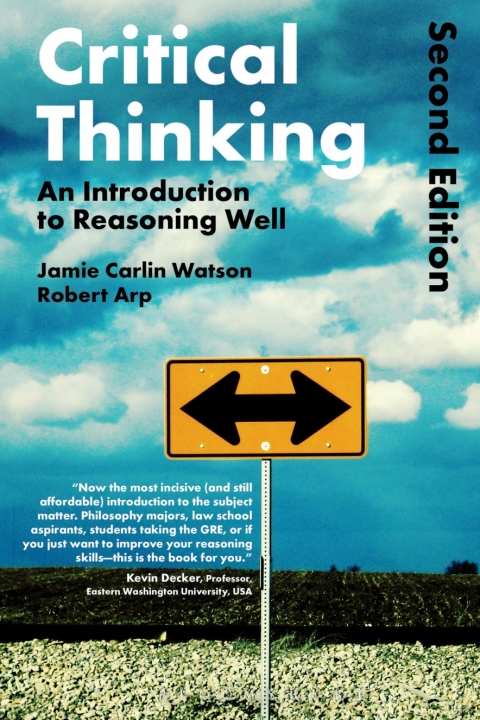Description
Efnisyfirlit
- Half-Title
- Title
- Contents
- Acknowledgments
- Preface to the 2nd edition
- Also available from Bloomsbury
- Part One The basics of good reasoning
- 1 The basic tools of reasoning
- Claims
- Different types of claims
- Operators
- Major operators
- Quantifiers
- Evidence
- Emotions as evidence?
- Arguments
- Identifying arguments
- Real-life examples
- 2 Evaluating arguments
- Extraneous material
- Implicit claims (enthymemes and disguised claims)
- Questions used as claims
- Ambiguity and vagueness
- Ambiguity: Lexical and syntactic
- Vagueness
- Argument form
- Two types of argument: Deductive and inductive
- Deductive arguments: Validity and soundness
- Inductive arguments
- Good arguments: The battery analogy
- Inductive strength indicators
- Strong claims?
- Simple and complex arguments
- Wrapping up: Evaluating arguments
- Real-life examples
- Part Two Deductive reasoning
- 3 Thinking and reasoning with categories
- Categories
- Relating categories to one another
- Standard-form categorical claims
- Parts of categorical claims
- Translating singular expressions and proper nouns
- The traditional square of opposition
- The super/subalternation of A-claims and I-claims, and E-claims and O-claims
- Conversion, obversion, and contraposition
- Translation tips
- Syllogisms and testing for validity with Venn diagrams
- Valid syllogisms, A-claims and E-claims, and the distributed middle term
- The limitations of categorical logic
- Real-life examples
- 2. Mexican Holy Week
- 4 Basic propositional logic
- A new language
- Translating English claims into claims of propositional logic
- Translating claims with operators
- Well-formed formulas
- The major operator
- Basic translation
- Tips for translating more difficult phrases
- Translating arguments
- Real-life examples
- 5 Truth tables
- Constructing truth tables: The basics
- Truth tables for operators
- Using truth tables to test for validity: The long method
- The long method of testing for validity
- Using truth tables to test for validity: The short method
- Real-life examples
- 6 Rules of deductive inference
- Deductive inference
- Four basic rules of valid inference
- Simplification
- Conjunction
- modus ponens
- modus tollens
- Eleven valid rules of replacement
- DeMorgan’s Laws
- Two valid proof strategies
- Three mistakes to avoid: Formal fallacies
- Real-life examples
- Part Three Inductive reasoning
- 7 Probability and inductive reasoning
- Inductive arguments
- Inductive strength
- Types of probability
- Conditional probabilities
- Using probability to guide decisions: The cost–benefit analysis
- An obstacle: The problem of induction
- Real-life examples
- General Principle of Reasoning Used
- Further Development of Argument
- 8 Generalization, analogy, and causation
- Inductive generalization
- Errors in statistics and probability
- The regression fallacy
- The base rate fallacy
- The gambler’s fallacy
- Argument from analogy
- Strengths and weaknesses of analogies
- Causal arguments
- Explanations vs. arguments
- Evaluating causal arguments
- Real-life examples
- 9 Scientific experiments and inference to the best explanation
- Testing causal claims
- The structure of a scientific experiment
- Simple models of confirmation and disconfirmation
- Complex models of confirmation and disconfirmation
- Formal experiments
- Informal experiments
- A problem for causal tests: Underdetermination
- A new type of argument: Inference to the best explanation
- Explanatory virtues
- Applying the virtues
- Three examples
- Real-life examples
- 10 Informal fallacies
- Formal and informal fallacies
- Hasty generalization and false cause
- Argumentum ad hominem, abusive (appeal to the man/person)
- Argumentum ad hominem, circumstantial
- Tu quoque (“you, too” or hypocrite fallacy)
- Argumentum ad populum (appeal to the people)
- Appeal to snobbery/vanity
- Argumentum ad verecundiam (appeal to inappropriate authority)
- Argumentum ad baculum (appeal to force)
- Argumentum ad misericordiam (appeal to pity or other emotions)
- Argumentum ad ignorantiam (appeal to ignorance)
- Circular argument (begging the question)
- Straw man
- Red herring
- Slippery slope
- False dilemma
- Composition and division
- Real-life examples
- Part Four Application
- 11 Putting it all together
- Applying critical thinking skills
- Two readings for evaluation
- Hints for evaluation
- Hints for evaluation
- Additional readings for evaluation
- Hints for evaluation
- Hints for evaluation
- Hints for evaluation
- Some assignment suggestions
- 12 Reasoning on graduate school entrance exams
- Introduction to graduate school entrance exams
- Basic analytic reasoning questions
- Interpreting complicated instructions
- Strengthen/weaken questions
- Inference questions
- Logic puzzles or games
- Flaw questions
- Parallel-the-reasoning questions
- Glossary
- Index






Reviews
There are no reviews yet.